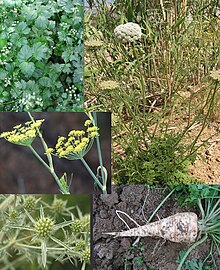
Back خيمية Arabic خيميه ARZ Apiaceae AST Çətirkimilər Azerbaijani Парасонавыя Byelorussian Парасонавыя BE-X-OLD Сенникови Bulgarian Apiaceae BS Apiàcies Catalan Apiaceae CEB
| Apiaceae | |
|---|---|

| |
| Apiaceae: Apium leaves and tiny inflorescences, Daucus habit, Foeniculum inflorescences, Eryngium inflorescences, Petroselinum root. | |
| Scientific classification | |
| Kingdom: | Plantae |
| Clade: | Tracheophytes |
| Clade: | Angiosperms |
| Clade: | Eudicots |
| Clade: | Asterids |
| Order: | Apiales |
| Family: | Apiaceae Lindl. |
| Type genus | |
| Apium | |
| Subfamilies | |
| |
| Synonyms | |
|
Umbelliferae | |
Apiaceae (/eɪpiːˈeɪsiˌaɪ, -siːˌiː/) or Umbelliferae is a family of mostly aromatic flowering plants named after the type genus Apium, and commonly known as the celery, carrot or parsley family, or simply as umbellifers. It is the 16th-largest family of flowering plants, with more than 3,800 species in about 446 genera,[1] including such well-known, and economically important plants as ajwain, angelica, anise, asafoetida, caraway, carrot, celery, chervil, coriander, cumin, dill, fennel, lovage, cow parsley, parsley, parsnip and sea holly, as well as silphium, a plant whose exact identity is unclear and may be extinct.[2]
The family Apiaceae includes a significant number of phototoxic species, such as giant hogweed, and a smaller number of highly poisonous species, such as poison hemlock, water hemlock, spotted cowbane, fool's parsley, and various species of water dropwort.
- ^ Stevens, P.F. (2001 onwards). "APIACEAE Lindley, nom. cons." Angiosperm Phylogeny Website. Retrieved 16 December 2022.
- ^ Gorvett, Zaria (7 September 2017). "The mystery of the lost Roman herb". BBC. Retrieved 4 June 2018.